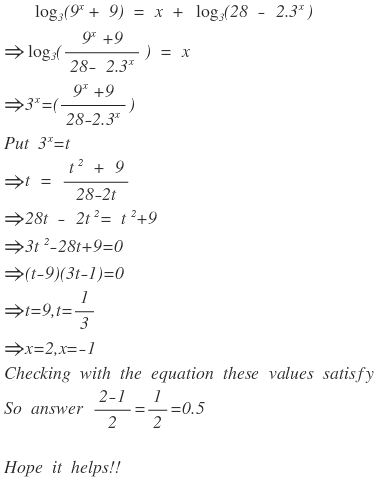Logarithm Basics Part IV
lo g 3 ( 9 x + 9 ) = x + lo g 3 ( 2 8 − 2 ⋅ 3 x )
If a 1 , a 2 , . . . a n are the real roots of the above equation, then find the value of n a 1 + a 2 + . . . + a n
Join the Brilliant Classes and enjoy the excellence.
The answer is 0.5.
This section requires Javascript.
You are seeing this because something didn't load right. We suggest you, (a) try
refreshing the page, (b) enabling javascript if it is disabled on your browser and,
finally, (c)
loading the
non-javascript version of this page
. We're sorry about the hassle.
2 solutions
while solving quadratic equation in 3 x you can assume it like a = 3 x . it will easy the solution
Moderator note:
Simple standard approach for solving such logarithm equations.
Always remember to check that the solutions do indeed satisfy the original equation. The sequence of steps are not if and only if because we cannot take the logarithm of a negative number.

This equation can be rewritten as
lo g 3 ( 9 x + 9 ) = lo g 3 ( 3 x ) + lo g 3 ( 2 8 − 2 ∗ 3 x )
⟹ lo g 3 ( 9 x + 9 ) = lo g 3 ( 3 x ( 2 8 − 2 ∗ 3 x ) ) .
Now as the log function is one-to-one we can equate arguments to find that
( 3 2 ) x + 9 = 3 x ( 2 8 − 2 ∗ 3 x ) ⟹ ( 3 x ) 2 + 9 = 2 8 ∗ 3 x − 2 ∗ ( 3 x ) 2
⟹ 3 ∗ ( 3 x ) 2 − 2 8 ∗ 3 x + 9 = 0 ,
which is quadratic in 3 x with solutions
3 x = 2 ∗ 3 2 8 ± 2 8 2 − 4 ∗ 3 ∗ 9 = 6 2 8 ± 2 6 = 3 1 4 ± 1 3 .
We thus have that either 3 x = 3 1 4 + 1 3 = 9 ⟹ x = 2 or
3 x = 3 1 4 − 1 3 = 3 1 ⟹ x = − 1 .
The reader can confirm that both these values of x satisfy the original equation. Thus the desired solution is 2 2 + ( − 1 ) = 0 . 5 .